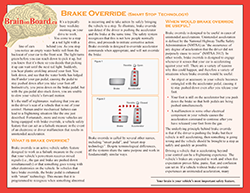Brake Override
Visual rebranding is in progress for these resources.
Lorem ipsum dolor sit amet, consectetur adipiscing elit. Morbi sed finibus metus, ac lobortis ante. Donec in suscipit augue. Nulla fringilla tempus ante congue tincidunt. Donec ligula nulla, tristique ut turpis quis, congue volutpat enim. Quisque tempor dictum accumsan. Phasellus faucibus blandit magna, vel tincidunt dolor laoreet vitae. Maecenas sodales iaculis libero non efficitur. Ut consequat tempor dolor, vitae interdum diam placerat a. Donec vitae eros id orci dignissim dapibus sed in lacus. Phasellus quis metus sit amet augue vehicula volutpat. Suspendisse sapien quam, convallis nec vestibulum non, sodales a ipsum.
What is brake override?
Brake override is an active vehicle safety feature designed to work as a failsafe measure in the event that your vehicle receives mixed signals (i.e., the gas and the brake are pushed down simultaneously) or an electrical malfunction causes the vehicle to continue accelerating even when the driver’s foot is on the brake. In vehicles with brake override, the brake pedal is enhanced with “smart” technology that detects when something abnormal occurs. For example, brake override can detect if the brake pedal and accelerator are pushed at the same time. It recognizes that this is not how people normally drive, and corrects the problem by overriding the accelerate command and bringing the vehicle to a safe stop.
Brake override is called by several other names, including “smart pedal” and “smart stop technology”. Despite the different names, all the systems work in fundamentally similar ways.
When would brake override be useful?
Brake override is designed to engage whenever it senses that the vehicle is accelerating beyond what the driver intends. This is called “unintended acceleration”, and there are a variety of reasons why it could happen, including the following:
- An object becomes entangled with the accelerator pedal causing it to stay down after the driver has released their foot.
- Both the accelerator and brake pedal are accidentally pushed simultaneously.
- An electrical malfunction causes the vehicle to accelerate beyond the driver’s intention.
The underlying principle behind brake override is that if the driver is pushing the brake but the vehicle is still accelerating, then something is going wrong and the vehicle should be brought to a stop as safely and quickly as possible.
How does brake override work?
Brake override technology is possible because modern vehicles are controlled by a fully integrated electronic system (“drive-by-wire”). This allows various sensors in the vehicle to transmit information to a single, overarching electronic control unit (ECU).
Prior to the invention of ECUs, vehicles relied exclusively on mechanical or hydraulic (as opposed to electronic) controls, which complicated the installation and integration of other features and limited the ways in which different aspects of the vehicle’s performance could be connected.
Brake override is a function of the ECU, and does not require the addition of further parts. It works by continuously checking the position of the brake and accelerator pedals for potential conflicts, for example, if both are pressed down at the same time. If a conflict is detected, brake override engages and the ECU either ignores the accelerator pedal completely or significantly reduces the effect of having the accelerator pedal pushed down. In some vehicles, the accelerator command is overridden by partially closing the accelerator throttle. Other systems reduce fuel flow to the engine, while brake override setups in hybrid vehicles weaken the force of the electronic current driving the vehicle.
How effective is brake override?
There is little data available on the exact number of crashes that could be prevented with brake override. Nevertheless, leading traffic safety organizations including the National Highway Traffic Safety Administration (NHTSA) in the United States have concluded that the possibility of a stuck accelerator pedal is serious enough to present a significant traffic safety issue, even if the exact number of cases is presently undetermined.
Estimates of the potential benefits of brake override are encouraging. For example, NHTSA has identified thousands of complaints of unintended accelerations over the past ten years. NHTSA estimates that brake override would prevent most crashes where a stuck accelerator pedal was to blame (NHTSA 2012).
Does brake override have any limitations?
Yes. Like many other vehicle safety features, getting the most out of brake override depends on whether drivers understand its purpose and interact appropriately with it. Brake override is special in the sense that it functions primarily as a failsafe measure in very specific situations. This means that brake override is not designed, for example, to help drivers stop sooner or maintain a safe speed. Drivers must still remain vigilant in poor driving conditions and remain attentive to the driving task at all times.
Unintended accelerations are by definition not controlled. As such, it is hard to say how far and at what speed a driver will travel before brake override stops the vehicle, even in dry conditions. To reduce the risk of collision before brake override stops the acceleration, drivers should always maintain a safe speed and leave plenty of distance between themselves and other vehicles.
Drivers can also take measures to prevent unintended accelerations. While some are caused by electrical malfunctions, others are caused by two-footed driving or loose objects becoming stuck around the gas pedal. Drivers should make sure that their driving technique is safe, that footwear cannot get stuck around the pedals, that the space at their feet is clear, and that objects in the car are secured in place.
How common is brake override in today’s vehicles?
Brake override was first introduced in the late 1980s as a performance enhancement for certain racing styles that involved two-footed driving, i.e., driving with one foot on the accelerator and one foot on the brake. Its potential as a safety feature was soon recognized and many vehicle manufacturers have been installing it on vehicles for over a decade. In addition, since brake override is simple to install on modern drive-by-wire vehicles, its prevalence has increased substantially over the years. To find out if your vehicle has brake override or is eligible to be fitted with brake override, please consult the owner’s manual.


